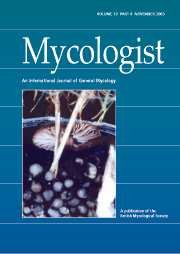Article contents
Teaching Techniques for Mycology: 23. Eclosion of Hypoxylon fragiforme ascospores as a prelude to germination
Published online by Cambridge University Press: 24 December 2004
Extract
It is well known that many fungi are host-specific, i.e. their fruiting is restricted to one host plant or a group of closely related hosts. An example is Hypoxylon fragiforme whose perithecial stromata are common on dead trunks and branches of beech, Fagus sylvatica (Fig 1), but are only occasionally found on other woody hosts. Mycelium of H. fragiforme is present mainly in the sapwood rather than the bark of branches of healthy beech trees, and this fungus has therefore been called a xylotropic endophyte (Chapela, 1989). Colonization is not extensive so long as the water content of infected host tissue remains high, but if branches are cut from living trees and allowed to dry, the mycelium extends rapidly (Chapela & Boddy, 1988a,b; Chapela, 1989).
- Type
- Original Article
- Information
- Copyright
- © 2004 The British Mycological Society
- 2
- Cited by




